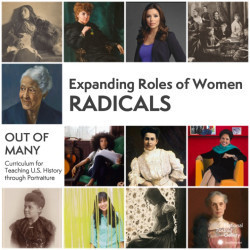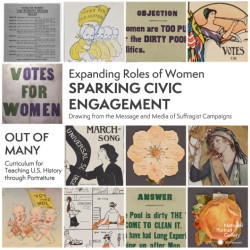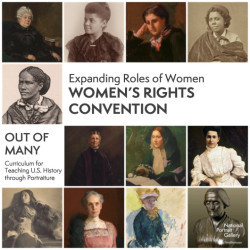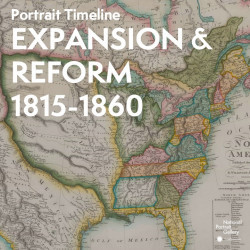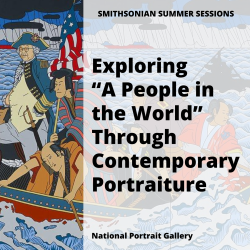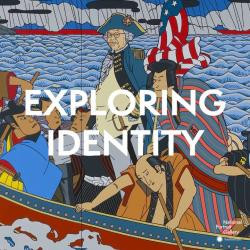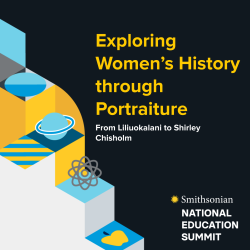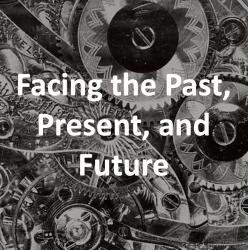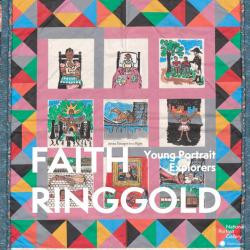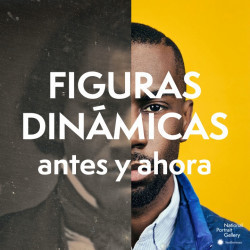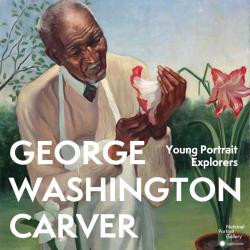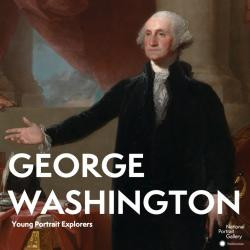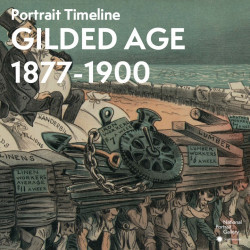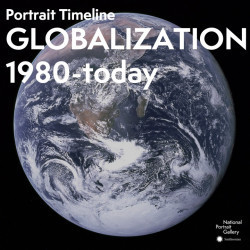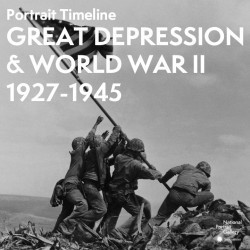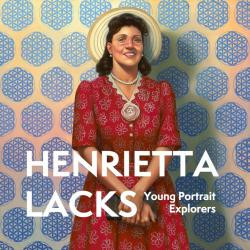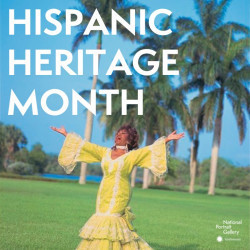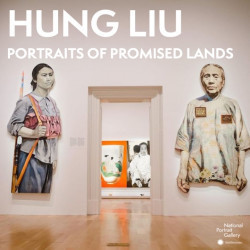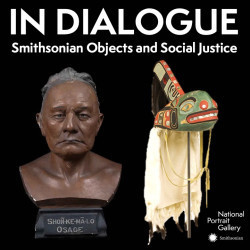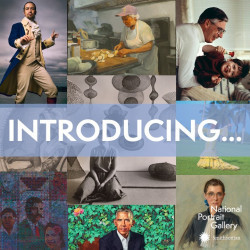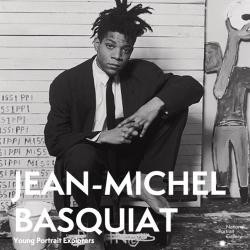Nicole Vance's collections
Expanding Roles of Women: Radicals
<p>In this Learning Lab collection, radical women featured in the Smithsonian’s National Portrait Gallery exhibition,<em> Out of Many: Portraits from 1600 to 1900, </em>are used as entry points to teach about the history of radicals during this time period.<br></p>
<p>From 1600 to 1900, women dramatically expanded their roles in politics and the professional sphere, including the arts. This set of Teaching Ideas explores the biographies and careers of those “radical” women who dared to create change in the cultural, political, and social spheres. Specifically, these lessons highlight Indigenous and Black activists who, despite being excluded from the broader suffrage movement, forged inroads for education and public awareness of racial inequities. The multi-hyphenate Zitkála-Šá grew up on the Yankton Sioux reservation in South Dakota. She cultivated her skill as a musician and writer, all in the face of forced assimilation at an Indian boarding school. Later, she advocated for Native American suffrage. Mary Church Terrell and Ida B. Wells-Barnett were influential political organizers. The increasing racial terrorism inflicted upon African American men ignited their activism. They would later become leaders in the women’s suffrage movement, founding clubs and organizations that would become hotspots for political mobilization. This section also addresses the ways that women artists and intellectuals used portraiture to promote a certain “visual identity,” or the elements and stylings that shape their public image.</p>
<p>Throughout this collection, students will examine not only the portrait subjects but will also gain insight into the larger historical time period in which the subjects lived, understand how the women in these portraits lived and located agency, and reflect on the present by considering how women continue to make changes in society.</p>
<p>This collection contains three lessons that highlight radical women: "Reading Portraiture: A Different Schooling," "Engaging History: Making Inferences with Primary Sources," and "Connections to the Present: Visual Identity."</p>
<p><strong><br></strong></p>
<p><strong>Reading Portraiture: A Different Schooling</strong><br></p>
<p>Students will gain an understanding of Zitkála-Šá’s experiences as a student and teacher at Indian boarding schools, particularly regarding how those experiences shaped her cultural identity and activism. To begin the lesson, students will explore their own identities. They will then compare and contrast two portraits of Zitkála-Šá. In addition, they will analyze an excerpt from one of Zitkála-Šá’s short stories.</p>
<p>Essential Questions</p>
<ul>
<li>How did Indian boarding schools impact the identities of Native Americans? What are their generational effects on Native cultures?</li>
<li>How do portraits demonstrate the complex identities of individuals?</li>
<li>What can we learn about an author’s beliefs by reading their work?</li>
</ul>
<p>Objectives</p>
<ul>
<li>Students will consider the complexities of their own identities and think about how they would represent themselves in a portrait.</li>
<li>Students will compare and contrast different portraits of Zitkála-Šá to consider the facets of the subject’s identity.</li>
<li>Students will analyze and annotate a primary source document.</li>
</ul>
<hr>
<p><strong>Engaging History: Making Inferences with Primary Sources</strong></p>
<p> </p>
<p>Students will examine cultural artifacts to gain an understanding of Mary Church Terrell’s radical approach to racial equality and women’s suffrage. First, students will read a portrait of Terrell, using the “See/Think/Wonder” thinking routine to spark their curiosity. Second, the teacher will model how to investigate primary sources and record inferences on a graphic organizer. Then student groups will move through a Gallery Walk to analyze a variety of primary sources and fill out their own inferences.</p>
<p>Essential Questions</p>
<ul><li>How can portraits initiate a deeper analysis of a person’s biography?</li><li>What can primary sources tell us about women activists in history?</li><li>How has Mary Church Terrell paved the way for today’s activists?</li></ul>
<p>Objectives</p>
<ul><li>Students will use thinking routines to begin a historical exploration of a portrait subject.</li><li>Students will analyze primary sources to make inferences about Mary Church Terrell’s life.</li><li>Students will compare the approaches of past and present activists</li></ul>
<p></p>
<hr>
<p><strong>Connections to the Present: Visual Identity</strong><br></p>
<p>In this lesson, students will determine what constitutes a “visual identity,” or the elements and stylings that shape a person’s public image. When people appear in public, they emphasize certain traits or characteristics, such as keen fashion sense, bold speech, or winsome facial expressions. On social media and other visual platforms, people savvily use physical appearance and personality to create a public-facing self.</p>
<p>Students will examine how portraiture was used to shape or define visual identity in the nineteenth century and how it is used today. Visual identity is a strategy to convey political aims and actions, as in the collective portrayal of suffragists and writers in Eminent Women. Alternately, visual identity can heighten a public version of the self, as in the striking pose of thespian Minnie Maddern Fiske. To conclude this lesson, students will draw connections between these nineteenth-century portraits and portraits of today’s radical women.</p>
<p>Essential Questions</p>
<ul><li>Which Elements of Portrayal contribute to an online presentation of the self?</li><li>Which values, identities, and actions can a work of art promote?</li><li>How have some women used portraiture to further their professional and political aims?</li></ul>
<p>Objectives</p>
<ul><li>Analyze the visual identity of the historical and contemporary portrait subjects.</li><li>Identify one present-day radical woman whose politics and personhood align with those of the historical women featured in the National Portrait Gallery’s portraits of Eminent Women and Minnie Maddern Fiske.</li></ul>
<hr>
<p>#NPGteach #OutOfMany</p>
<p>Keywords: Radicals, Women, Zitkala-Ša, Indian Boarding Schools, Yankton Dakota, American Indian Women, American Indian Citizenship, American Indian Activism, Primary Sources, Mary Church Terrell, Suffrage, M Street Colored School, Visual identity, Eminent Women, Minne Maddern Fiske, portraiture, portraits, </p>
 Nicole Vance
Nicole Vance
71
Expanding Roles of Women: Sparking Civic Engagement Assessment
<p>This Learning Lab collection can be used as an assessment conclusion to the study of the portraits in <a href="https://learninglab.si.edu/q/ll-c/pPEjlxzvSDYKI29e#r/61864">Expanding Roles of Women</a> or used alongside an existing unit of study on women’s suffrage or related topics. Sparking Civic Engagement, asks students to study ephemera from the campaign for suffrage. Students then create a campaign promotional item, such as a piece of apparel or a broadside, to take a stand on a current gender-based issue.<br></p>
<p></p>
<p>This assessment asks students to draw connections between the history of women’s suffrage in the United States and current gender-based issues, encouraging them to take a stand. First, students will study ephemera, or the ordinary, often transient objects, from the U.S. women’s suffrage movement: Among other artifacts, they will review a selection of witty banners that amplified the goals of protestors. They will also examine the resolute rhetoric of broadsides, the printed manifestos of the movement. Using these artifacts as models, students will then brainstorm current gender-based issues surfacing in their communities. Finally, students will design and create a campaign strategy and accompanying promotional materials, such as posters or apparel, to address their selected issue.</p>
<p></p>
<hr>
<p>#NPGteach #OutOfMany</p>
<p>Keywords: Suffrage, Civic Engagement, Campaign, Broadside, Postcards, Gender</p>
 Nicole Vance
Nicole Vance
34
Expanding Roles of Women: Suffragists
<p>In this Learning Lab collection, suffragists featured in the Smithsonian’s National Portrait Gallery exhibition,<em> Out of Many: Portraits from 1600 to 1900 </em>are used as entry points to teach about the history of the suffrage during this time period. </p>
<p>During the nineteenth and early twentieth centuries, many women sought voting rights as the foundation of women’s rights, and they were often viewed as radical for having such a goal. As daughters and wives, women in the United States had few decision-making rights, let alone the right to own and control land, so having the power to make political decisions through suffrage was seen as extreme. When Elizabeth Cady Stanton initiated the first woman’s rights convention at Seneca Falls in 1848, some attendees expressed this concern. The struggle for women’s suffrage was rooted in the abolition movement and anti-slavery societies, where Black and white women organized together to end slavery. White suffragists learned from leading Black women abolitionists like Sojourner Truth and Frances Ellen Watkins Harper, who had been organizing and speaking publicly for many years before Seneca Falls. By the end of the Civil War, when voting rights for Black men were written into law, racism began to divide the suffragists.</p>
<p>Although Susan B. Anthony worked with Stanton to end slavery, they did not believe that Black men should gain suffrage before white women. In this set of Teaching Ideas, students will examine the details of this divide and discover how suffragists fought for women’s rights and social justice issues. For example, the journalist Ida B. Wells-Barnett advocated for Black women’s rights, including suffrage, and protested the lynching of African Americans. Lawyer Belva Ann Lockwood not only believed in women’s right to political representation but also in their capability of holding the highest office in the land: She ran for president in 1884 and 1888.</p>
<p>Throughout this collection, students will examine not only the portraits subjects but will also; gain insist into the larger historical time period in which the subjects lived, understand how the women in these portraits lived and located agency, and reflect on the present by considering how women continue to make changes in society.</p>
<p>This collection contains three lessons that highlight the American suffragist movement: "Reading Portraiture: Striking a Pose," "Engaging History: Unity and Division Within the Women's Suffrage Movement," and "Connections to the Present: Women Presidential Candidates."</p>
<hr>
<p><strong>Reading Portraiture: Striking a Pose</strong></p>
<p>In this lesson, students step into the roles of two leaders of the American women’s suffrage movement: Elizabeth Cady Stanton and Ida B. Wells. One of the most famous suffragists, Stanton was a founder of the National Woman Suffrage Association (NWSA) and a prolific writer and theorist of feminist thought. Wells was an investigative journalist and newspaper editor who led an antilynching campaign and fought for women’s suffrage. In addition, she founded the politically influential Alpha Suffrage Club, which aimed to give a voice to African American women who were excluded from mainstream suffrage organizations.</p>
<p>Inspired by the suffragists’ political use of the tableau vivant, or a carefully posed, motionless scene with living actors, this lesson will ask students to closely study—and bring to life—Stanton and Wells’ portraits and polemics.</p>
<p>Essential Questions</p>
<ul><li>Which Elements of Portrayal lend visual power to a portrait?</li><li>To what extent does a sitter’s pose convey a sense of authority and selfhood?</li></ul>
<p>Objectives </p>
<ul><li>Study the social and historical implications of primary sources and original works of art.</li><li>Extend the analysis of nineteenth-century portraits of suffragists into a dramatic, kinesthetic interpretation.</li><li>Identify some of the primary principles of the women’s suffrage movement.</li></ul>
<hr>
<p><strong>Engaging History: Unity and Division Within the Women’s Suffrage Movement</strong></p>
<p>Students will gain an understanding of the unity and division within the women’s suffrage movement through a two-part lesson. They will enter the lesson by considering how history is told through portraits, in terms of who is represented and who is not. The notable absence of African American abolitionists and suffragists from the Coronation of Womanhood group portrait provides a launching point to investigate why these individuals were sidelined from the women’s suffrage movement. At the same time, students will learn about instances when African American and white women came together in their struggle for equal rights.</p>
<p>The first part of the lesson involves gathering background information from a short video and reading. Then, students will analyze primary sources that convey the unity within the women’s suffrage movement. For the second part of the lesson, students will do more in-depth investigation into the various perspectives and debates around strategies for achieving women’s suffrage, which exemplify division within the movement. During an interactive “Chalk Talk,” students will respond to both quotes from these historical debates as well as to the opinions of their fellow classmates.</p>
<p>Essential Questions</p>
<ul><li>How has portraiture been used to represent the history of women’s suffrage?</li><li>How can we account for the missing or underrepresented perspectives in history and what can we do to change the narrative?</li><li>What caused division within the women’s suffrage movement?</li></ul>
<p>Objectives </p>
<ul><li>Students will explore how portraits present history.</li><li>Students will analyze additional primary sources to understand changes within the women’s suffrage movement.</li><li>Students will investigate suffragists’ differing perspectives.</li></ul>
<hr>
<p><strong>Connections to the Present: Women Presidential Candidates</strong></p>
<p></p>
<p>Students will conceptualize portraits of women who ran for president in the late nineteenth century and more recently. They will begin by examining former presidential candidate Shirley Chisholm’s portrait. During the main part of the lesson, they will make connections between women who have run for presidential office in recent years and Belva Ann Lockwood, a suffragist who was a two-time presidential candidate in the 1880s.</p>
<p>Students will delve into women’s biographies by reading articles and conducting independent research. Afterward, they will create a portrait of a woman presidential candidate based on the Elements of Portrayal and the biographies they have read.</p>
<p>Essential Questions</p>
<ul><li>How do the experiences of historical women who ran for president compare to those of women today?</li><li>Which factors does an artist consider when creating a portrait of the president or presidential candidate of the United States?</li></ul>
<p>Objectives </p>
<ul><li>Students will investigate women’s biographies to understand what motivated them to run for president of the United States.</li><li>Students will apply their knowledge of reading portraiture and the Elements of Portrayal to create portraits of women candidates for presidential office.</li></ul>
<p></p>
<hr>
<p>#NPGteach #OutOfMany</p>
<p>Keywords: Suffrage, Suffragists, Suffragette, Women's Suffrage, Portraiture, Voting Rights, Enfranchisement, Nineteenth Amendment, Seneca Falls, Susan B. Anthony, Elizabeth Cady Stanton, Ida B. Wells, Sojourner Truth, Abigail Scott Duniway, Frances Ellen Watkins Harper, Frederick Douglass, Lucy Stone, American Equal Rights Association (AERA), Belva Ann Lockwood, Shirley Chisholm, Female Presidential Candidates, Female President, Campaign, See/Think/Wonder, Strike a Pose, Tableaux Vivants, Chalk Talk, Portraiture, Making Portraits<br></p>
 Nicole Vance
Nicole Vance
74
Exploring “A People in the World” Through Contemporary Portraiture (Smithsonian Summer Sessions)
<p>How can portraiture reveal what it means to be an American in a global context? Inspired by Educating for Democracy's <a href="https://www.educatingforamericandemocracy.org/the-roadmap/7themes/#people-in-the-world">"A People in the World" theme</a>, this collection gathers resources and pedagogical approaches to support the 2022 <em>Smithsonian Summer Sessions</em> workshop, “Exploring “A People in the World” Through Contemporary Portraiture,” by introducing techniques to engage students in civic engagement.</p>
<p>Workshop facilitated by National Portrait Gallery Educators Irina Rubenstein and Briana Zavadil White.</p>
<p><strong>Learning Objectives</strong></p>
<p>Students will:<br></p>
<ul><li>Engage in observation and analysis of portraiture (visual literacy; critical thinking)</li><li>Explore different experiences and perspectives in order to examine what it means to be "a people in the world."</li><li>Utilize portraiture to connect to the bigger picture and educate for global competence.</li></ul>
<ul></ul>
<p>#SummerSessions #NPGteach</p>
 Nicole Vance
Nicole Vance
16
Exploring Identity through Portraiture
<p>This Learning Lab complements the National Portrait Gallery's student program, Exploring Identity through Portraiture.</p>
<p>Exploring Identity through Portraiture explores the ways in which artists and sitters use portraiture as a means to convey individual, community/cultural, and national identity. By analyzing portraits, including self-portraits, students will consider how the artists tell the sitters’ stories, paying attention to how the artists’ choices reveal some—but perhaps not all—aspects of the sitters’ identity. Students will explore how portraiture can be an avenue that they can use to represent their own identities and make meaning of what is important to them.<br></p>
<p><strong>Objectives</strong></p>
<p><strong></strong>After completing this lesson, students will be better able to: </p>
<p>• Examine how modern and contemporary artists use portraiture to reveal aspects of a sitter’s individual, community/cultural, and national identity. </p>
<p>• Identify key components of a portrait and discuss what one can learn about the sitter through these components. </p>
<p>• Discuss the artistic choices that portrait artists make and consider how such decisions can reveal the artists’ viewpoints and also influence the viewers’ understanding of the sitters’ identity. </p>
<p>• Use the museum’s collection as a gateway to investigating and exploring one’s own individual, community/cultural, and national identity.</p>
<p>#NPGteach</p>
 Nicole Vance
Nicole Vance
70
Exploring Women's History Through Portraiture: From Liliuokalani to Shirley Chisholm (Smithsonian National Education Summit)
<p>How can women's stories centered in the classroom? In what ways can portraiture spark civic change? This collection features portraits, strategies, and lessons for teaching about the history of women in the United States to support the 2022 <em>Smithsonian National Education Summit</em> session, "Exploring Women's History Through Portraiture: From Liliuokalani to Shirley Chisholm." With a focus on drawing connections to the present, this collection seeks to empower educators and students by introducing them to new ideas for integrating art, and civics that center on stories of women. </p>
<p>Workshop facilitated by Ashleigh Coren (Smithsonian American Women's History Initiative and National Portrait Gallery), Briana Zavadil White (National Portrait Gallery), and Amy Trenkle (Ida B Wells MS). <br></p>
<p><strong>Learning Objectives</strong></p>
<p>Educators will:</p>
<ul><li>Identify elements of portrayal in order to read portraiture </li><li>Learn about hidden histories of women</li><li>Examine the importance of sharing different historical perspectives</li><li>Collaboratively brainstorm how to integrate resources into the classroom.</li></ul>
<p>#NationalEducationSummit #TogetherWeThrive #NPGteach<br></p>
 Nicole Vance
Nicole Vance
24
Figuras dinámicas: antes y ahora
<p>Este <em>Learning Lab</em> (Laboratorio de aprendizaje) complementa el programa para estudiantes de la National Portrait Gallery 2020-2021. Esta colección complementa la serie de programas que ofrece la National Portrait Gallery para estudiantes de tercer grado del DCPS (Escuelas Públicas del Distrito de Columbia), “Figuras dinámicas: antes y ahora”.</p>
<p>La serie “Figuras dinámicas: antes y ahora” recurre al retrato para establecer relaciones transversales en el plan de estudios. A lo largo del año académico, las clases de tercer grado del DCPS tendrán la oportunidad de conocer la Galería Nacional de Retratos a través tres visitas únicas durante el otoño, el invierno y la primavera. Más allá de que asistan a una, dos o tres sesiones, los estudiantes podrán apreciar el poder del retrato en sus diversos aspectos. Este programa se ajusta directamente a los objetivos de aprendizaje del tercer grado. A través de debates interactivos, así como de actividades de dibujo, escritura y motoras, los estudiantes leerán, resolverán problemas, compararán y contrastarán los distintos retratos de la colección. Los estudiantes aprenderán a interpretar retratos y a reconocer el valor del arte del retrato en una variedad de escenarios y circunstancias. </p>
<p>Una vez que completen esta lección, los estudiantes estarán mejor capacitados para:</p>
<p>Identificar a estadounidenses importantes y analizar sus contribuciones a la historia de los Estados Unidos</p>
<p>Identificar los elementos clave de un retrato y conversar sobre las cosas que se pueden aprender acerca del modelo retratado a través de ellos.</p>
<p>#NPGteach</p>
<p><br></p>
<p>La traducción de este recurso fue posible gracias al generoso patrocinio de Bank of America.</p>
 Nicole Vance
Nicole Vance
52
George Washington Carver: Young Portrait Explorers
<p>Discover this portrait of George Washington Carver, and use your five senses to learn about his job as a scientist, inventor, and teacher.</p>
<p>#NPGteach</p>
<p><strong>Keywords:</strong> George Washington Carver, five senses, scientist, agriculture, botany, inventor, teacher</p>
 Nicole Vance
Nicole Vance
42
George Washington: Young Portrait Explorers
<p>Learn about the first president of the United States, George Washington.</p>
<p>#NPGteach</p>
<p><strong>Keywords:</strong> George Washington, President, Executive Branch, Revolutionary War</p>
 Nicole Vance
Nicole Vance
28
Henrietta Lacks: Young Portrait Explorers
<p>Discover the life of Henrietta Lacks through Kadir Nelson’s vibrant portrait and learn about her legacy (or her important place in history). </p>
<p>Keywords: Henrietta Lacks, HeLa, Cells, Biology, Cancer</p><p>#NPGteach</p>
 Nicole Vance
Nicole Vance
25
Hispanic Heritage Month with the National Portrait Gallery
<p>Meet the Hispanic Americans who shaped the history, development, and culture of the United States of America. Use this collection to celebrate Hispanic Heritage Month and embrace Hispanic voices in the classroom year round.<br></p>
<p>#NPGteach</p>
<p><strong>Keywords: </strong>Portraits, Hispanic Heritage Month, Latinx History Month, Latina, Latino, Afro-Latino, Puerto Rican, Nuyorican, Chicana, Chicano, Scientists, Writers, Artists, Musicians, Actors, Activists, Government</p>
 Nicole Vance
Nicole Vance
215
Hung Liu: Portraits of Promised Lands
<p>Explore portraits from "Hung Liu: Portraits of Promised Lands" at the Smithsonian's National Portrait Gallery in this Learning Lab collection.<br></p>
<p>Hung Liu (1948–2021) was a contemporary Chinese-born American artist, whose multilayered paintings established new frameworks for understanding portraiture in relation to time, memory, and history. Often sourcing her subjects from photographs, Liu elevated overlooked individuals by amplifying the stories of those who have historically been invisible or unheard. Having lived through war, political revolution, exile, and displacement, she offered a complex picture of an Asian Pacific American experience. Her portraits speak powerfully to those seeking a better life, in the United States and elsewhere. <em>Hung Liu: Portraits of Promised Lands</em> will be first major exhibition of the artist's work on the East Coast. This is also the first time that a museum will focus on Liu’s portraiture.</p>
<p><em>The story of America as a destination for the homeless and hungry of the world is not only a myth. It is a story of desperation, of sadness, of uncertainty, of leaving your home. It is also a story of determination, and—more than anything—of hope.</em></p>
<p>— Hung Liu, 2017</p>
<p><em></em>"Hung Liu: Portraits of Promised Lands" will be on view at the National Portrait Gallery August 27, 2021, through May 30, 2022</p>
<p>Keywords: Hung Liu, Chinese-American, AAPI, Cultural Revolution, China, Portraits, Portraiture, Family, Mother, Father, Daughter, Son, Gender, Refugees, Immigration, Identification, Identity, Displacement, War, Asian Pacific American, Painting, Photography, Memory, Migration, Dorothea Lange, Carrie Mae Weems</p>
 Nicole Vance
Nicole Vance
57

